Inhibitory Potential of the Drimane Sesquiterpenoids Isotadeonal and Polygodial in the NF-kB Pathway
Abstract
1. Introduction
2. Results
2.1. Epimerization of Polygodial
2.2. Cell Viability
2.3. Drimane Sesquiterpenoids Modulate the Expression of NF-kB-SEAP
2.4. Drimane Sesquiterpenoids Modulate the Expression of IkB-α
2.5. Molecular Docking
2.6. Pharmacokinetic Features—ADMET
3. Discussion
4. Materials and Methods
4.1. Cell Culture
4.2. Polygodial and Isotadeonal
4.3. Cell Viability Analysis in Response to Treatments
4.4. Expression of NF-kB-SEAP
4.5. Western Blot Analysis
4.6. In Silico Analysis
4.7. Pharmacokinetic Features—ADMET
4.8. Statistical Analysis
5. Conclusions
Supplementary Materials
Author Contributions
Funding
Institutional Review Board Statement
Informed Consent Statement
Data Availability Statement
Acknowledgments
Conflicts of Interest
Abbreviations
| ADMET | Absorption, Distribution, Metabolism, Excretion and Toxicity |
| BBB | Blood brain barrier |
| CAPE | Phenethyl ester of caffeic acid |
| CNS | Central nervous system |
| DMSO | Dimethylsulfoxide |
| ESOL | Solubility class |
| GI | Gastrointestinal |
| HBA | Hydrogen bond acceptors |
| HBD | Hydrogen bond donors |
| HMC-3 | Human microglial cell clone 3 |
| ICAM1 | Intercellular adhesion molecule 1 |
| IKK | IκB kinase |
| log P | Partition coefficient |
| LPS | Lipopolysaccharide |
| MIC | Minimum inhibitory concentration |
| MW | Molecular weight |
| NMR | Nuclear magnetic resonance |
| NF-κB | Nuclear factor-κB |
| P-gp | Inhibitor of permeability glycoprotein |
| RB | Number of rotatable bonds |
| Rf | Retention factor |
| SEAP | Secreted alkaline phosphatase |
| TLC | Thyn layer chromatography |
| TPSA | Predicted topological polar surface area |
| TRPA1 | Transient receptor potential ankyrin 1 |
| TRPV1 | Transient receptor vanilloid 1 |
| VCAM1 | Vascular cell adhesion molecule 1 |
References
- Yamamoto, Y.; Gaynor, R. Role of the NF-KB Pathway in the Pathogenesis of Human Disease States. Curr. Mol. Med. 2005, 1, 287–296. [Google Scholar] [CrossRef]
- Israël, A. The IKK Complex, a Central Regulator of NF-KappaB Activation. Cold Spring Harb. Perspect. Biol. 2010, 2, a000158. [Google Scholar] [CrossRef]
- Liu, T.; Zhang, L.; Joo, D.; Sun, S.C. NF-ΚB Signaling in Inflammation. Signal Transduct. Target. Ther. 2017, 2, 17023. [Google Scholar] [CrossRef]
- Oeckinghaus, A.; Ghosh, S. The NF-KappaB Family of Transcription Factors and Its Regulation. Cold Spring Harb. Perspect. Biol. 2009, 1, a000034. [Google Scholar] [CrossRef]
- Merighi, S.; Nigro, M.; Travagli, A.; Gessi, S. Microglia and Alzheimer’s Disease. Int. J. Mol. Sci. 2022, 23, 12990. [Google Scholar] [CrossRef]
- Chekalina, N.; Burmak, Y.; Petrov, Y.; Borisova, Z.; Manusha, Y.; Kazakov, Y.; Kaidashev, I. Quercetin Reduces the Transcriptional Activity of NF-KB in Stable Coronary Artery Disease. Indian Heart J. 2018, 70, 593–597. [Google Scholar] [CrossRef]
- Pérez, R.; Burgos, V.; Marín, V.; Camins, A.; Olloquequi, J.; González-Chavarría, I.; Ulrich, H.; Wyneke, U.; Luarte, A.; Ortiz, L.; et al. Caffeic Acid Phenethyl Ester (CAPE): Biosynthesis, Derivatives and Formulations with Neuroprotective Activities. Antioxidants 2023, 12, 1500. [Google Scholar] [CrossRef]
- Celli, N.; Dragani, L.K.; Murzilli, S.; Pagliani, T.; Poggi, A. In Vitro and in Vivo Stability of Caffeic Acid Phenethyl Ester, a Bioactive Compound of Propolis. J. Agric. Food Chem. 2007, 55, 3398–3407. [Google Scholar] [CrossRef]
- Yang, L.L.; Xiao, N.; Li, X.W.; Fan, Y.; Alolga, R.N.; Sun, X.Y.; Wang, S.L.; Li, P.; Qi, L.W. Pharmacokinetic Comparison between Quercetin and Quercetin 3-O-β-Glucuronide in Rats by UHPLC-MS/MS. Sci. Rep. 2016, 6, 35460. [Google Scholar] [CrossRef]
- Wilhelm de Möesbach, E. Botanica Indígena de Chile; Andres Bello: Santiago, Chile, 1992. [Google Scholar]
- Cárcamo, G.; Silva, M.; Becerra, J.; Urrutia, H.; Sossa, K.; Paz, C. Inhibition of Quorum Sensing by Drimane Lactones from Chilean Flora. J. Chil. Chem. Soc. 2014, 59, 2622–2624. [Google Scholar] [CrossRef]
- Paz, C.; Cárcamo, G.; Silva, M.; Becerra, J.; Urrutia, H.; Sossa, K. Drimendiol, a Drimane Sesquiterpene with Quorum Sensing Inhibition Activity. Nat. Prod. Commun. 2013, 8, 147–148. [Google Scholar] [CrossRef]
- Bombaça, A.C.S.; Von Dossow, D.; Barbosa, J.M.C.; Paz, C.; Burgos, V.; Menna-Barreto, R.F.S. Trypanocidal Activity of Natural Sesquiterpenoids Involves Mitochondrial Dysfunction, ROS Production and Autophagic Phenotype in Trypanosomacruzi. Molecules 2018, 23, 2800. [Google Scholar] [CrossRef] [PubMed]
- Paz, C.; Viscardi, S.; Iturra, A.; Marin, V.; Miranda, F.; Barra, J.; Mendez, I.; Duran, P. Antifungal Effects of Drimane Sesquiterpenoids Isolated from Drimys winteri against Gaeumannomyces graminis var. tritici. Appl. Environ. Microbiol. 2020, 86, e01834-20. [Google Scholar] [CrossRef] [PubMed]
- Marin, V.; Iturra, A.; Opazo, A.; Schmidt, B.; Heydenreich, M.; Ortiz, L.; Jim, A.; Paz, C. Oxidation of Isodrimeninol with PCC Yields Drimane Derivatives with Activity against Candida Yeast by Inhibition of Lanosterol 14-Alpha Demethylase. Biomolecules 2020, 10, 1101. [Google Scholar] [CrossRef]
- De La Chapa, J.; Singha, P.K.; Sallaway, M.; Self, K.; Nasreldin, R.; Dasari, R.; Hart, M.; Kornienko, A.; Just, J.; Smith, J.A.; et al. Novel Polygodial Analogs P3 and P27: Efficacious Therapeutic Agents Disrupting Mitochondrial Function in Oral Squamous Cell Carcinoma. Int. J. Oncol. 2018, 53, 2627–2636. [Google Scholar] [CrossRef]
- Escalera, J.; Von Hehn, C.A.; Bessac, B.F.; Sivula, M.; Jordt, S.E. TRPA1 Mediates the Noxious Effects of Natural Sesquiterpene Deterrents. J. Biol. Chem. 2008, 283, 24136–24144. [Google Scholar] [CrossRef]
- Burgos, V.; Paz, C.; Saavedra, K.; Saavedra, N.; Foglio, M.A.; Salazar, L.A. Drimenol, Isodrimeninol and Polygodial Isolated from Drimys Winteri Reduce Monocyte Adhesion to Stimulated Human Endothelial Cells. Food Chem. Toxicol. 2020, 146, 111775. [Google Scholar] [CrossRef]
- Barrosa, K.H.; Mecchi, M.C.; Rando, D.G.; Ferreira, A.J.S.; Sartorelli, P.; Valle, M.M.R.; Bordin, S.; Caperuto, L.C.; Lago, J.H.G.; Lellis-Santos, C. Polygodial, a Sesquiterpene Isolated from Drimys Brasiliensis (Winteraceae), Triggers Glucocorticoid-like Effects on Pancreatic β-Cells. Chem. Biol. Interact. 2016, 258, 245–256. [Google Scholar] [CrossRef]
- Marín, V.; Bart, B.; Cortez, N.; Jiménez, V.A.; Silva, V.; Leyton, O.; Cabrera-Pardo, J.R.; Schmidt, B.; Heydenreich, M.; Burgos, V. Drimane Sesquiterpene Aldehydes Control Candida Yeast Isolated from Candidemia in Chilean Patients. Int. J. Mol. Sci. 2022, 23, 11753. [Google Scholar] [CrossRef]
- Anke, H.; Sterner, O. Comparison of the Antimicrobial and Cytotoxic Activities of Twenty Unsaturated Sesquiterpene Dialdehydes from Plants and Mushrooms. Planta Medica 1991, 57, 344–346. [Google Scholar] [CrossRef]
- Rodríguez, B.; Zapata, N.; Medina, P.; Viñuela, E. A Complete 1H and 13C NMR Data Assignment for Four Drimane Sesquiterpenoids Isolated from Drimys Winterii. Magn. Reson. Chem. 2005, 43, 82–84. [Google Scholar] [CrossRef] [PubMed]
- Zahra, M.; Abrahamse, H.; George, B.P. Flavonoids: Antioxidant Powerhouses and Their Role in Nanomedicine. Antioxidants 2024, 13, 922. [Google Scholar] [CrossRef] [PubMed]
- Karin, M.; Yamamoto, Y.; Wang, Q.M. The IKK NF-ΚB System: A Treasure Trove for Drug Development. Nat. Rev. Drug Discov. 2004, 3, 17–26. [Google Scholar] [CrossRef] [PubMed]
- Park, H.; Shin, Y.; Choe, H.; Hong, S. Computational Design and Discovery of Nanomolar Inhibitors of IκB Kinase β. J. Am. Chem. Soc. 2015, 137, 337–348. [Google Scholar] [CrossRef]
- Gleeson, M.P.; Hersey, A.; Montanari, D.; Overington, J. Probing the Links between in Vitro Potency, ADMET and Physicochemical Parameters. Nat. Rev. Drug Discov. 2011, 10, 197–208. [Google Scholar] [CrossRef]
- AmeliMojarad, M.; AmeliMojarad, M. The Neuroinflammatory Role of Microglia in Alzheimer’s Disease and Their Associated Therapeutic Targets. CNS Neurosci. Ther. 2024, 30, e14856. [Google Scholar] [CrossRef]
- Park, J.; Min, J.S.; Kim, B.; Chae, U.B.; Yun, J.W.; Choi, M.S.; Kong, I.K.; Chang, K.T.; Lee, D.S. Mitochondrial ROS Govern the LPS-Induced pro-Inflammatory Response in Microglia Cells by Regulating MAPK and NF-ΚB Pathways. Neurosci. Lett. 2015, 584, 191–196. [Google Scholar] [CrossRef]
- Singh, A.; Ansari, V.A.; Mahmood, T.; Ahsan, F.; Wasim, R. Neurodegeneration: Microglia: Nf-Kappab Signaling Pathways. Drug Res. 2022, 72, 496–499. [Google Scholar] [CrossRef]
- Guo, S.; Wang, H.; Yin, Y. Microglia Polarization From M1 to M2 in Neurodegenerative Diseases. Front. Aging Neurosci. 2022, 14, 815347. [Google Scholar] [CrossRef]
- Yao, K.; Zu, H. bing Microglial Polarization: Novel Therapeutic Mechanism against Alzheimer’s Disease. Inflammopharmacology 2020, 28, 95–110. [Google Scholar] [CrossRef]
- Oeckinghaus, A.; Hayden, M.S.; Ghosh, S. Crosstalk in NF-ΚB Signaling Pathways. Nat. Immunol. 2011, 12, 695–708. [Google Scholar] [CrossRef] [PubMed]
- Da Cunha, L.R.; Muniz-Junqueira, M.I.; Dos Santos Borges, T.K. Impact of Polyphenols in Phagocyte Functions. J. Inflamm. Res. 2019, 12, 205–217. [Google Scholar] [CrossRef] [PubMed]
- Teleanu, R.I.; Preda, M.D.; Niculescu, A.G.; Vladâcenco, O.; Radu, C.I.; Grumezescu, A.M.; Teleanu, D.M. Current Strategies to Enhance Delivery of Drugs across the Blood–Brain Barrier. Pharmaceutics 2022, 14, 987. [Google Scholar] [CrossRef] [PubMed]
- Tian, S.; Li, Y.; Wang, J.; Zhang, J.; Hou, T. ADME Evaluation in Drug Discovery. 9. Prediction of Oral Bioavailability in Humans Based on Molecular Properties and Structural Fingerprints. Mol. Pharm. 2011, 8, 841–851. [Google Scholar] [CrossRef]
- Bazzi, M.; Badros, A. Multiple Myeloma: Implementing Signaling Pathways and Molecular Biology in Clinical Trials. Cancer Biol. Ther. 2010, 10, 830–838. [Google Scholar] [CrossRef]
- Mirzaei, S.; Zarrabi, A.; Hashemi, F.; Zabolian, A.; Saleki, H.; Azami, N.; Hamzehlou, S.; Farahani, M.V.; Hushmandi, K.; Ashrafizadeh, M.; et al. Nrf2 Signaling Pathway in Chemoprotection and Doxorubicin Resistance: Potential Application in Drug Discovery. Antioxidants 2021, 10, 349. [Google Scholar] [CrossRef]
- Lopachin, R.M.; Gavin, T. Molecular Mechanisms of Aldehyde Toxicity: A Chemical Perspective. Chem. Res. Toxicol. 2014, 27, 1081–1091. [Google Scholar] [CrossRef]
- Paz, C.; Ortiz, L.; Deuis, J.R.; Vetter, I. Polygodial, a Drimane Sesquiterpenoid Dialdehyde Purified from Drimys Winteri, Inhibits Voltage-Gated Sodium Channels. Nat. Prod. Res. 2022, 36, 6318–6323. [Google Scholar] [CrossRef]
- O’Boyle, N.M.; Banck, M.; James, C.A.; Morley, C.; Vandermeersch, T.; Hutchison, G.R. Open Babel. J. Cheminform. 2011, 3, 33. [Google Scholar] [CrossRef] [PubMed]
- Pettersen, E.F.; Goddard, T.D.; Huang, C.C.; Couch, G.S.; Greenblatt, D.M.; Meng, E.C.; Ferrin, T.E. UCSF Chimera—A Visualization System for Exploratory Research and Analysis. J. Comput. Chem. 2004, 25, 1605–1612. [Google Scholar] [CrossRef]
- Trott, O.; Olson, A.J. AutoDock Vina: Improving the Speed and Accuracy of Docking with a New Scoring Function, Efficient Optimization, and Multithreading. J. Comput. Chem. 2010, 31, 455–461. [Google Scholar] [CrossRef] [PubMed]
- Li, A.P. Screening for Human ADME/Tox Drug Properties in Drug Discovery. Drug Discov. Today 2001, 6, 357–366. [Google Scholar] [CrossRef] [PubMed]
- Daina, A.; Michielin, O.; Zoete, V. SwissADME: A Free Web Tool to Evaluate Pharmacokinetics, Drug-Likeness and Medicinal Chemistry Friendliness of Small Molecules. Sci. Rep. 2017, 7, 42717. [Google Scholar] [CrossRef]
- Banerjee, P.; Kemmler, E.; Dunkel, M.; Preissner, R. ProTox 3.0: A webserver for the prediction of toxicity of chemicals. Nucleic Acids Res. 2024, 52, W513–W520. [Google Scholar]
- Ferreira, M.I.; Gonçalves, G.G.; Ming, L.C. Polygonum Punctatum Elliott; 2018; pp. 393–400. [Google Scholar] [CrossRef]
- Ferreira, B.A.; Norton Filho, A.F.; Deconte, S.R.; Tomiosso, T.C.; Thevenard, F.; Andrade, S.P.; Lago, J.H.G.; Araújo, F.D.A. Sesquiterpene Polygodial from Drimys Brasiliensis (Winteraceae) Down-Regulates Implant-Induced Inflammation and Fibrogenesis in Mice. J. Nat. Prod. 2020, 83, 3698–3705. [Google Scholar] [CrossRef]
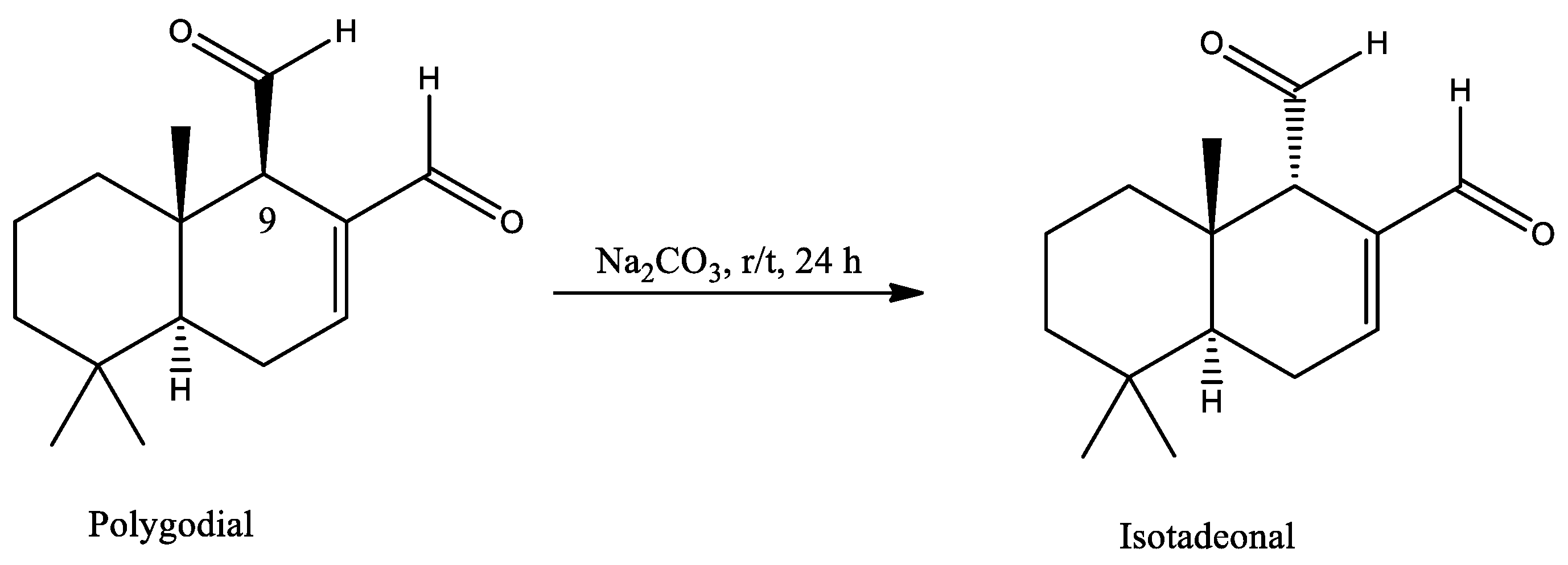

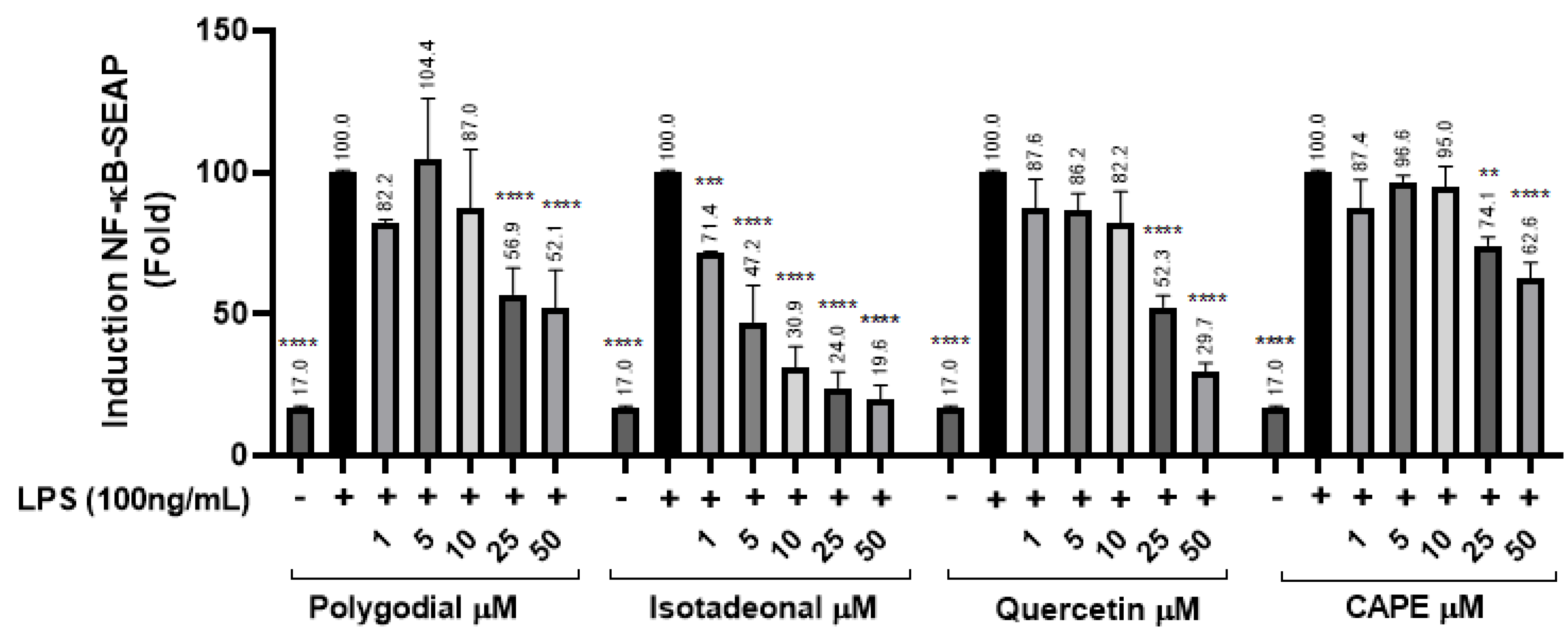

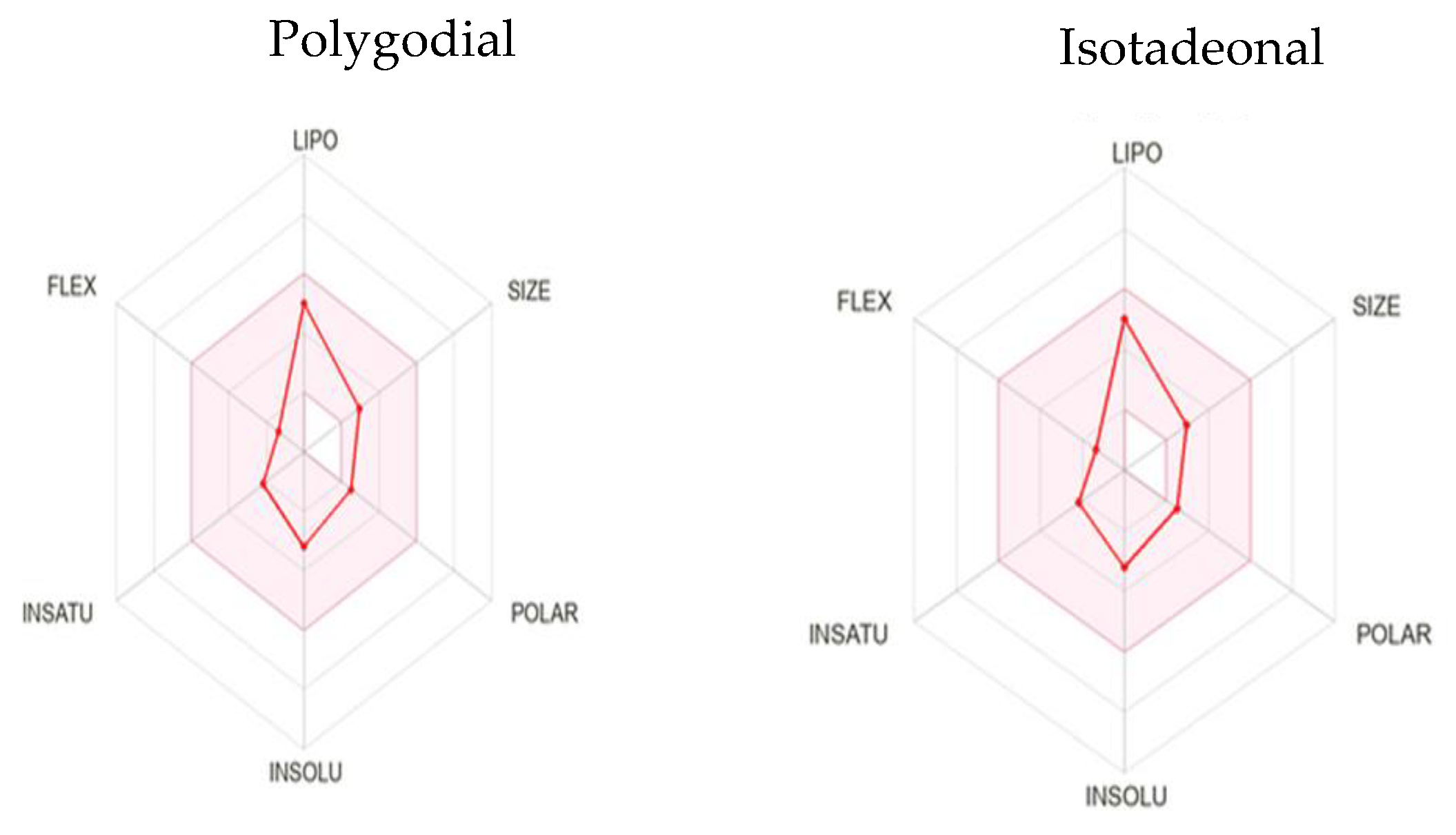
| Compound | Binding Energy (kcal/mol) | Number of Interactions | Interacting Amino Acids |
|---|---|---|---|
| Polygodial | −6.68 | 3 | Cys99, Val152, Leu21 |
| Isotadeonal | −7.12 | 4 | Cys99, Val152, Leu21 |
| Compound | 2D Binding Interactions | 3D Pocket Positioning |
|---|---|---|
| Polygodial | 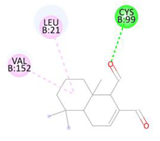 |  |
| Isotadeonal | 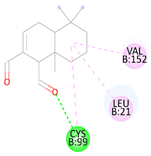 | 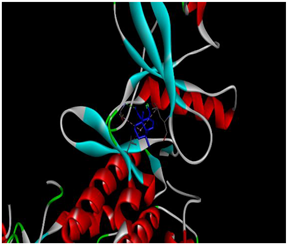 |
| Pharmacokinetics/Druglikeness | Isotadeonal | Polygodial |
|---|---|---|
| #Rotatable bonds | 2 | 2 |
| #H-bond acceptors | 2 | 2 |
| #H-bond donors | 0 | 0 |
| TPSA | 34.14 | 34.14 |
| Consensus Log P | 2.93 | 2.89 |
| ESOL Class | −3.20 | −3.20 |
| GI absorption | High | High |
| BBB permeant | Yes | Yes |
| Pgp substrate | No | No |
| CYP1A2 inhibitor | No | No |
| CYP2C19 inhibitor | No | No |
| CYP2C9 inhibitor | No | No |
| CYP2D6 inhibitor | No | No |
| CYP3A4 inhibitor | No | No |
| log Kp (cm/s) | −5.44 | −5.44 |
| Lipinski | Yes | Yes |
| Bioavailability score | 0.55 | 0.55 |
| Log VDss (human) | 0.300 | 0.323 |
| CNS permeability | −2.131 | −2.131 |
| Synthetic Accessibility | 4.26 | 4.26 |
| Toxicity | ||
| AMES toxicity | No | No |
| Hepatotoxicity | No | No |
| hERG I/II inhibitors | No | No |
| Skin sensitization | Yes | Yes |
Disclaimer/Publisher’s Note: The statements, opinions and data contained in all publications are solely those of the individual author(s) and contributor(s) and not of MDPI and/or the editor(s). MDPI and/or the editor(s) disclaim responsibility for any injury to people or property resulting from any ideas, methods, instructions or products referred to in the content. |
© 2025 by the authors. Licensee MDPI, Basel, Switzerland. This article is an open access article distributed under the terms and conditions of the Creative Commons Attribution (CC BY) license (https://creativecommons.org/licenses/by/4.0/).
Share and Cite
Marín, V.; Villegas, C.; Ogundele, A.V.; Cabrera-Pardo, J.R.; Schmidt, B.; Paz, C.; Burgos, V. Inhibitory Potential of the Drimane Sesquiterpenoids Isotadeonal and Polygodial in the NF-kB Pathway. Molecules 2025, 30, 1555. https://doi.org/10.3390/molecules30071555
Marín V, Villegas C, Ogundele AV, Cabrera-Pardo JR, Schmidt B, Paz C, Burgos V. Inhibitory Potential of the Drimane Sesquiterpenoids Isotadeonal and Polygodial in the NF-kB Pathway. Molecules. 2025; 30(7):1555. https://doi.org/10.3390/molecules30071555
Chicago/Turabian StyleMarín, Víctor, Cecilia Villegas, Ayorinde Víctor Ogundele, Jaime R. Cabrera-Pardo, Bernd Schmidt, Cristian Paz, and Viviana Burgos. 2025. "Inhibitory Potential of the Drimane Sesquiterpenoids Isotadeonal and Polygodial in the NF-kB Pathway" Molecules 30, no. 7: 1555. https://doi.org/10.3390/molecules30071555
APA StyleMarín, V., Villegas, C., Ogundele, A. V., Cabrera-Pardo, J. R., Schmidt, B., Paz, C., & Burgos, V. (2025). Inhibitory Potential of the Drimane Sesquiterpenoids Isotadeonal and Polygodial in the NF-kB Pathway. Molecules, 30(7), 1555. https://doi.org/10.3390/molecules30071555









